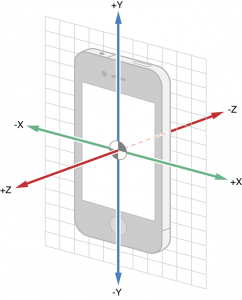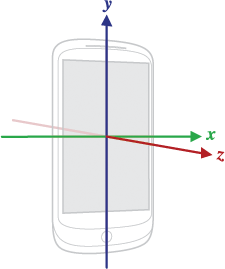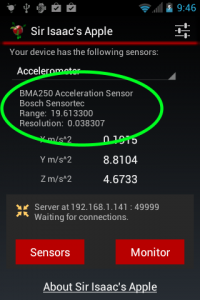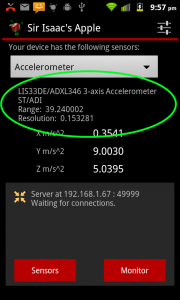Measurement Axes
Many devices, such as smart phones and the Broadcom WICED Sense, have embedded sensors that can measure acceleration, rotation, magnetic field, light, and other physical properties. Sensor measurements are given in a 3D coordinate system relative to the front, side, and top of the device. Both the iOS and the Android device use the same coordinate system: the x,y axes are defined by the screen bottom and side, and the z axis comes directly out of the screen.


Range and Resolution
A measuring device has a range and a resolution defining its capabilities and performance. For example, if you had a yard stick with inch marks, the range of your measurements would be 3 feet, and the resolution would be one inch. This is useful for measuring longer objects, but is not very precise. If you had a 30 cm ruler with millimeter marks, the range would be 300 mm, and the resolution would be 1 mm. This would be useful for measuring smaller things more precisely.
The range and resolution of the sensors on your Android device is visible on the main screen of the Isaac’s Apple Android application. The range and resolution values are specified in the measurement units for that particular sensor.
Consider the two accelerometers above. The first sensor has a smaller resolution number. It is three times more precise than the accelerometer on the right. The second accelerometer has a larger range, it can measure plus or minus 4g while the accelerometer on the left can only measure plus or minus 2g.
Types of Android Sensors
The Isaac’s Apple Android application can use any of the built in measurement sensors. The main page of the Android application shows which sensors are built into your device.
An Android device can have any of the following sensors.
Accelerometer
Measures the acceleration force applied to the device , in meters per second per second (m/s2). This measurement includes the force of gravity which is always acting on the device. For example, when the device is resting on a table, the accelerometer will be measuring 9.81 m/s2, which is the Earth’s gravitational pull.
Gravity
Measures the force of gravity along the device axes in meters per second per second (m/s2). When the device is at rest, the gravity sensor will show the same measurement as the accelerometer.
Linear Acceleration
Measures the acceleration force applied to the device, minus the force of gravity, in meters per second per second (m/s2). The linear acceleration measurement should be equivalent to the accelerometer measurement minus the gravity measurement. The linear acceleration measurement is usually calculated by the device software, although it can be a unique hardware sensor in some high end Android devices.
Gyroscope
Measures the rate of rotation around each of the axes in radians/second (rad/s). Rotation is positive in the counterclockwise direction.
Orientation Sensor
Measures the orientation of the device in a familiar reference frame. The orientation sensor measurements values are:
- X is Azimuth. This is the heading of the device relative to magnetic north. This value is between 0 and 360, where 0 would be facing toward the magnetic north pole, and 180 would be facing south.
- Y is Pitch. This is the rotation around the device X axis. This value is between – 180 and 180, where 0 would be with the device screen pointing to the sky, and 180 would be with the device screen pointing to the ground.
- Z is Roll. This is the rotation about the device Y axis. This value is between -90 and 90, where 0 would be with the device screen pointing to the sky, and 90 would be with the device screen pointing to the left.
Rotation Vector
Similar to the orientation sensor, the rotation vector measures the orientation of the device relative to north, east, and up. The rotation vector measurement provides orientation values in a format used by many graphics and navigation applications. The orientation of a device is measured as a combination of an angle and an axis, in which the device has rotated through an angle θ around an axis <x, y, z>. The rotation vector measurements are:
- X value is: x * sin(θ/2)
- Y value is: y * sin(θ/2)
- Z value is: z * sin(θ/2)
- A value is: cos (θ/2)
Note: the A value is not plotted in the Sir Isaac’s Apple graphs, you must convert the experiment file to .CSV if you wish to process rotation vector measurements
Where the axes are defined as:
- Y axis points towards north
- X axis points east
- Z axis points to the sky (is perpendicular to the ground).
Magnetic Field
Measures the magnetic field around the device in micro-Tesla (uT). This measurement will always include the effects of the Earth’s magnetic field.
Light
Measures the ambient light level in lux (lx). The Android device light sensor provides only a single value, therefore this sensor reports only an X value, and the Y and Z values are not used.
Proximity
This sensor is derived from the light sensor. It provides a value of 1 to 7 as an estimate of distance to a close by object. This measurement is one dimensional, so there is only an X value.
Temperature
Measures the ambient room temperature in degrees Celsius (C). This measurement is one dimensional, so there is only an X value.
Pressure
Measures the ambient air temperature in hectopascals (hPa). This measurement is one dimensional, so there is only an X value.
Relative Humidity
Measures the ambient relative humidity in percent. This measurement is one dimensional, so there is only an X value.
Types of iOS Sensors
Accelerometer
Measures the acceleration force applied to the device , in units of standard gravity (g). One g = 9.81 m/s^2. This measurement includes the force of gravity which is always acting on the device.
Gyroscope
Measures the rate of rotation around each of the axes in radians/second (rad/s). Rotation is positive in the counterclockwise direction.
Magnetic Field
Measures the magnetic field around the device in micro-Tesla (uT). This measurement will always include the effects of the Earth’s magnetic field.


